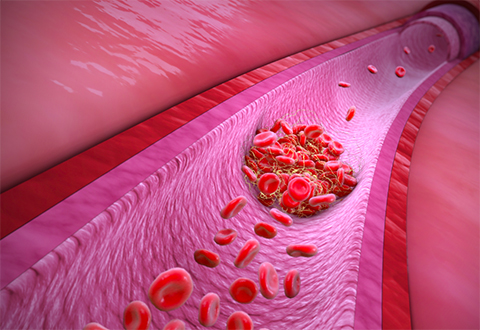From the journals: JLR
A “T” makes a difference in blood clotting. High cholesterol: two screens are better than one. Biomarkers for cardiovascular risk. Statin-induced changes to the HDL lipidome. Read about papers on these topics recently published in the Journal of Lipid Research.
A “T” makes a difference in blood clotting
Increased risk of blood clotting, or thrombosis, is a central feature of cardiovascular disease. Individuals who suffer from coronary artery disease, or CAD, and acute coronary syndrome are at an increased risk of developing blood clots. Phosphatidylserine, or PS, is an anionic phospholipid and a key component of cellular membranes. It is also one of several cofactors required for blood clotting. PS is structurally similar to phosphatidylthreonine, or PT, but has a serine residue instead of a threonine residue. PS has been well-studied, and although PT has been detected in animal tissues, mammalian cell cultures, bacteria, and parasitic protozoa, it has not previously been studied in human tissue. If present in human tissues, PT may perform similar functions to PS.
Ali Hajayah of Cardiff University and a multidisciplinary team were the first to detect PT in human blood, platelets, leukocytes and extracellular vesicles, or EVs, and investigate its connection to CAD. They published their results in the Journal of Lipid Research. Using liquid chromatography-tandem mass spectrometry, the researchers detected several molecular species of PT in human blood, washed platelets, EVs and isolated leukocytes from healthy individuals. By comparing the blood PT profile of CAD patients with healthy individuals, the team found that PT levels were significantly higher in platelets from CAD patients. In addition, PT could enhance prothrombinase activity, indicating that it has procoagulant activity.
These results suggest that PT may play a role in atherosclerotic vascular disease. During future studies, the authors will evaluate the role of PT in coagulation and programmed cell death and its link to vascular disease.
High cholesterol: two screens are better than one
According to the Centers for Disease Control and Prevention, familial hypercholesterolemia, or FH, affects one in 250 people in the general population. The likelihood of having coronary heart disease, or CAD, at a younger age increases with an FH diagnosis. In a fasting individual, very high levels of low-density lipoprotein cholesterol, or LDL-C, are usually associated with a clinical FH presentation. Early confirmation of FH, particularly in young individuals, could allow for better disease management and a more positive prognosis.
In a recent Journal of Lipid Research study of more than 1,000 individuals in Portugal, Ana Margarida Medeiros of the National Institute of Health of Doctor Ricardo Jorge and her team characterized the genetic background of individuals with FH. The researchers confirmed FH at the genetic level, classified FH variants according to the latest guidelines and identified genotypic variants of diseases similar to FH, such as polygenic hypercholesterolemia. This data suggests that a combined approach using the biochemical profile and genetic background of individuals with FH may be the first step in managing the disease.
Biomarkers for cardiovascular risk
Angiopoietin-like proteins, or ANGPTLs, are a family of eight members, and they play important roles in fat and glucose metabolism. They do so by inhibiting lipoprotein lipase, or LPL, activity. LPL converts triglycerides, or TGs, to fatty acids and glycerol, which regulates how the body processes fats. Inhibition of LPL activity affects how fats are stored in adipose tissue or used as fuel in skeletal muscle under fed or fasting states. Dysregulation of fat metabolism is linked to developing cardiovascular disease.
In a recent study, published in the Journal of Lipid Research, 642 participants engaged in a five-month endurance exercise program. The researchers, William G. Hoffmann of the University of South Carolina and his team, found an association between ANGPTL3/8 and ANGPTL4/8 and blood lipids, total body fat composition, abdominal or visceral fat, insulin sensitivity and other factors throughout the study. At baseline, high levels of ANGPTL3/8 and ANGPTL4/8 were associated with a poor lipid, lipoprotein and cardiometabolic profile. ANGPTL3/8 significantly decreased with exercise training, which corresponded with increases in LPL activity and decreases in plasma triglycerides and visceral fat. These findings suggest that ANGPTL3/8 and ANGPTL4/8 levels affect both lipid profile and insulin sensitivity and as such, may serve as novel therapeutic targets to mitigate cardiovascular disease risk. Future studies will examine how diet, lifestyle and different types of exercise affect the ANGPTL family members.
Enjoy reading ASBMB Today?
Become a member to receive the print edition four times a year and the digital edition monthly.
Learn moreGet the latest from ASBMB Today
Enter your email address, and we’ll send you a weekly email with recent articles, interviews and more.
Latest in Science
Science highlights or most popular articles

Fueling healthier aging, connecting metabolism stress and time
Biochemist Melanie McReynolds investigates how metabolism and stress shape the aging process. Her research on NAD+, a molecule central to cellular energy, reveals how maintaining its balance could promote healthier, longer lives.

Mapping proteins, one side chain at a time
Roland Dunbrack Jr. will receive the ASBMB DeLano Award for Computational Biosciences at the ASBMB Annual Meeting, March 7–10, just outside of Washington, D.C.

Exploring the link between lipids and longevity
Meng Wang will present her work on metabolism and aging at the ASBMB Annual Meeting, March 7-10, just outside of Washington, D.C.

Defining a ‘crucial gatekeeper’ of lipid metabolism
George Carman receives the Herbert Tabor Research Award at the ASBMB Annual Meeting, March 7–10, just outside of Washington, D.C.

The science of staying strong
Muscles power every movement, but they also tell the story of aging itself. Scientists are uncovering how strength fades, why some species resist it and what lifestyle and molecular clues could help preserve muscle health for life.

Bacteriophage protein could make queso fresco safer
Researchers characterized the structure and function of PlyP100, a bacteriophage protein that shows promise as a food-safe antimicrobial for preventing Listeria monocytogenes growth in fresh cheeses.


